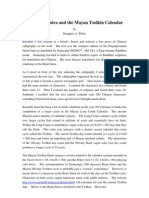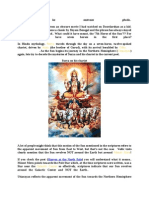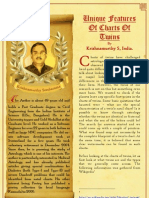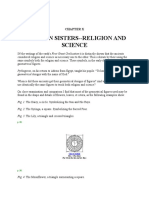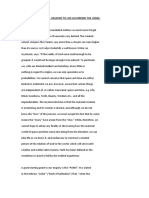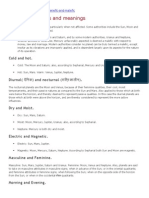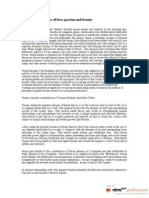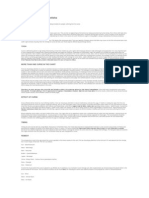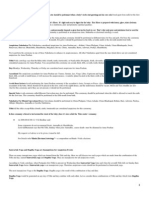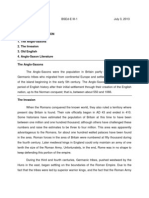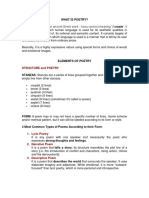A Vedic Key To The Zodiac
A Vedic Key To The Zodiac
Uploaded by
Horacio TackanooCopyright:
Available Formats
A Vedic Key To The Zodiac
A Vedic Key To The Zodiac
Uploaded by
Horacio TackanooOriginal Title
Copyright
Available Formats
Share this document
Did you find this document useful?
Is this content inappropriate?
Copyright:
Available Formats
A Vedic Key To The Zodiac
A Vedic Key To The Zodiac
Uploaded by
Horacio TackanooCopyright:
Available Formats
A Vedic Key to the Zodiac
The following article proposes a Vedic rationale for the nature and sequence of the twelve signs of the zodiac. It shows how the zodiac could have been invented as a form of Vedic sacrifice (Yajna) following the Vedic view of the ods! the worlds and the elements. "hile the complete logic ma# not be wor$ed out! enough has been revealed to show the probable main aspects of the s#stem. %sing this model man# secrets of the zodiac are uncovered. The Zodiac as a Fire Ritual (Yajna) The Vedas are based upon the concept of &gni or the sacred 'ire. The# set forth an elaborate 'ire ritual (Yajna) that is identified with time ($ala)! causation ($arma)! and space. This ritual defines the entire cosmic order (ritam or (harma). The ritual has several levels of application as elemental (adhibhutic)! ps#chological (adh#atmic) and spiritual (adhidaivic). The elemental level reflects the )arth! the gross elements! and the outer form of the sacrifice. The ps#chological level relates to the &tmosphere or middle realm and to our inner faculties of mind! prana! speech! sight and hearing. The spiritual level reflects *eaven! the ods or cosmic light forces s#mbolized b# the +un! ,oon and stars. In the Vedas Yajna is identified with the -reator (.rajapati or /rahma)! who through various Yajnas creates the world. Yet Yajna is also the activit# of the soul (the individual human being or 0iva)! who through the Yajna gains the fruits of $arma as well as union with the -reator. These two! the -reator and the soul! are one as the .urusha! or higher +elf. The .urusha is the universe personified as a human being! the cosmic man or person. The .urusha is identified with the +un! who is time and the 1ala .urusha or being of time. There are man# forms of Vedic Yajnas. &ll involve various offerings of pra#ers! mantras! ghee! and food to the sacred 'ire as it is en$indled at special times. The# are defined as dail#! monthl#! seasonal! or #earl#. (ail# Yajnas relate to 'ire and to the )arth! which is en$indled at sunrise! noon and sunset. ,onthl# Yajnas relate to the ,oon and to the &tmosphere! particularl# to the new! full and half ,oon. Yearl# Yajnas reflect the +un! *eaven! the seasons and the equino2es. The goal of the Yajna is to conquer these respective divisions of time in order to reach the eternal. This is also to conquer the different worlds or go be#ond space. .erformance of dail# Yajnas ta$es one be#ond the dualit# of da# and night and the world of the )arth. The monthl# Yajnas ta$e one be#ond the fluctuations of the month and the world of the ,oon or the &tmosphere. The #earl# Yajna ta$es one be#ond time and all of its fluctuations s#mbolized b# the #ear and the world of the +un or *eaven. 3n an inner level these Yajnas ta$e us be#ond mental and emotional fluctuations to the equanimit# of pure consciousness or pure internal light. Twelve da# (dwadashaha) and twelve month (#earl#) Yajnas were ver# important. Indeed the twelve da# Yajna is said to be the most important of Yajnas! through which .rajapati creates the world. The zodiac ma# evolve out of the idea of a twelvefold Yajna! a #earl# Yajna or the Yajna of the s$#. *owever the most common set of Vedic Yajnas is the si2 da# (sadaha) rite. )ach month of thirt# da#s was divided into five si2 da# rites. The si2 da# rites had both a da# and a night. The zodiac could also be a si2 da# rite! with two signs ma$ing for a da# and a night. Agni and Vayu (Fire and Air) and the Worlds of Earth and Water The first of the Vedic ods! therefore! is &gni or 'ire through whom the Yajna proceeds. 3f similar great importance is Va#u or Indra! who relates to &ir! wind! .rana or spirit. Indra is the foremost and most commonl# lauded of the Vedic ods. 3nce the 'ire is en$indled! the second stage of the Vedic ritual is for the &ir or spirit to manifest. The 'ire moves up to *eaven and then the "ind descends from *eaven to the )arth. &gni ('ire) generates Indra or Va#u ("ind or energ#). 'or e2ample! the first h#mn of the Rig Veda is to &gni or 'ire and the second is to Va#u or "ind. Va#u is said to be Ishwara! od or the -reator! or the cosmic spirit! the evident or manifest /rahma (prat#a$sha /rahma 4 Taittiriya Upanishad, +hantipatha)! the formless (ivinit#. &gni is identified with the individual soul and the form aspect of (ivinit#. *owever the cosmic form of &gni as the +un is identified with the -reator and the +upreme +pirit! who is also Va#u or Indra. )ach of these two great ods has its respective field of action. &gni is the deit# of the )arth (.rithivi). *e is en$indled on the )arth! in a speciall# dug )arth altar (vedi). The 'ire burns the wood from the )arth. )arth is also the ashes (bhasma) left over from the 'ire. Va#u is the deit# of the &tmosphere (&ntari$sha)! which is also identified with the "aters (&pas) or the 3cean. This is not onl# the field of the rains! but of the whole movement of "ater from the )arth to the s$# and bac$. The "aters also s#mbolize space! the cosmic waters. There are "aters beneath the )arth as well as above *eaven! through which Va#u moves ever#where. Va#u is the 5ord of the ocean ( Shukla Yajur Veda 66VIII.7). Indra8s main action is sla#ing the dragon who withholds the "aters to release them to flow into the sea. .utting &gni ('ire) and Va#u (&ir) together along with their related support worlds of the )arth and the "aters! we get the four elements behind the zodiac 4 'ire! )arth! &ir and "ater. & 'ire sign rests upon an )arth sign and an &ir sign rests upon a "ater sign! just as the sacred 'ire relates to )arth and "ind to "ater. 'ire signs represent &gni (light) and &ir signs represent Va#u (movement and order). These two are held or contained in )arth and "ater signs! which the# stimulate. 'ire lights up the )arth and &ir moves the "aters. The Threefold Uni erse
The Vedas spea$ of a tripartite or threefold universe. Though there are various threefold orders in the Vedas the most characteristic is the three worlds of )arth (.rithivi)! &tmosphere (&ntari$sha) or the "aters (&pas)! and *eaven ((#aus)! adding the third world of *eaven to the other two worlds alread# mentioned. The od of *eaven is +ur#a or the +un who can be identified either with &gni or with Va#u because he is the source of both light and life. 9ote the Brihaddevata of +hauna$a for a discussion of how the ods relate to the three worlds. &gni and all the Vedic ods! though the# have their prime form in one world! have additional forms in all three worlds. &gni is primaril# the sacred 'ire on )arth. Yet he is lightning (Vid#ut) in the &tmosphere! and the +un (+ur#a) in *eaven. )ach of the three forms of &gni has its )arth or world support which is its fuel! wood on the )arth! clouds in the &tmosphere and the stars in the s$#. The three worlds of )arth! &tmosphere and *eaven are called the three )arths because the# function as containers for the cosmic 'ire on these three different levels. Va#u or &ir similarl# has three forms in the three worlds. In the &tmosphere he is the thunder! represented b# the od :udra (+hiva) and other deities of the rains li$e the ,aruts. In *eaven he is associated with Indra! who is Va#u as the cosmic lord! and represents the solar wind or wind rising from the +un. Va#u on the )arth is associated with the sacred 'ire and its maintenance. &ll three forms are associated with cosmic law (ritam or (harma)! which is sustained b# Va#u and its right movement. The three worlds are also called the three "aters or three oceans. )ach form of Va#u is associated with a particular form of the "aters or the ocean. The )arth# or sacrificial form of &gni is associated with ground "ater and with caves and springs and with the water and ghee (clarified butter) that is offered to the 'ire. The &tmospheric wind (thunder) is associated the ocean and the rains which are created b# "ater evaporating from the sea. The *eavenl# (solar) wind is associated with the cosmic ocean and heavenl# "aters which are also the ,il$# "a#. +pace is the "aters of *eaven through which the +un moves li$e a boat. The zodiac is based upon a threefold division of the four elements. 0ust as the Vedas have the four elements! the# also have a threefold division of them relative to the three worlds. The threefold division of the signs reflects the Vedic idea of the three worlds of )arth! &tmosphere and *eaven and the three forms of &gni and Va#u operative within them. !dd and E en "igns The zodiac follows a two fold division of odd and even or male and female signs. 'ire and &ir signs are all odd or masculine signs representing force or energ#. )arth and "ater signs are all even or feminine signs representing the field or world in which the force operates. In this regard in the Vedic view the da# is *eaven and the night is the )arth. The da# rests upon the night as spirit upon matter. 'ire and &ir are the spirit. )arth and "ater are matter. The Zodiac in Vie# of Vedic $once%ts *owever! the correlations are more specific. The Vedic ritual begins with &gni or 'ire which corresponds to the beginning! birth! the eastern direction and sunrise. Therefore the zodiac should begin with a 'ire sign. The 'ire sign should be of a creative! moveable or active qualit# (cardinal or chara) in order to initiate the movement of time. This is the nature of the sign &ries. The qualities (cardinal! fi2ed and mutable or chara! sthira and dvisvabhava) of the other signs also become ma$e sense according to Vedic ideas. &gni is en$indled on the )arth altar and so a 'ire sign rests upon an )arth sign. This is the role of Taurus! which is associated with the ground and level places! as well as with wood and plants. Taurus is fi2ed (sthira) )arth! because 'ire needs a continuous fuel in order to burn. The interpla# between these two signs allows the &ir or Va#u to come forth! which is represented b# emini! the electrical force of the &tmosphere or thunder ((ivine speech). emini is a sign of speech! e2pression and movement. The twins show the basic dualit# of the air or electrical force and its forces of attraction and repulsion. It is also a changeable! mutable or dual natured signed (dvisvabhava) because wind is never constant in its movement. emini represents (harma or order in the atmospheric (and ps#chological) realm. &n &ir sign requires the support of a "ater sign on which it moves. This is the role of -ancer as the moving (chara or cardinal) "aters. These are the "aters that rise from the ocean of )arth to the ocean of the s$# and themselves ma$e up the ocean of the &tmosphere. In Vedic thought the &tmospheric ocean encompasses *eaven and )arth on both sides and so becomes a s#mbol of the waters and the worlds as a whole! the world of origin! -ancer as the world mother. Va#u also is connected to the ,oon and is said to be its protector (Rig Veda 6.;<.<). The second of the three sections of the zodiac begins with 5eo which represents the +un in *eaven! the heavenl# form of &gni or 'ire. The +un is fi2ed (sthira) 'ire because it gives light continuall#. 5eo as a 'ire sign is supported b# Virgo! an )arth sign. Virgo is the )arth made fertile b# the ra#s of the +un. Virgo is sometimes portra#ed as holding the stars! the field of the s$#. It is a changeable! mutable or dual natured sign (dvisvabhava). &fter these two signs comes 5ibra! another &ir sign! here the wind on the )arth. 5ibra is concerned with weighing and balancing! attracting and repulsion! the basic dualit# of .ranic or electrical forces in the material sphere. It is also a moveable! creative or cardinal sign (chara :ashi). It represents (harma or justice! the order of the sacrifice! on the )arth level. In this wa# it is opposite &ries and reflects the second half of the zodiac and a parallel movement of the sacrifice.
5ibra is followed b# +corpio! here the ground "ater or "ater beneath the )arth or the )arthl# ocean. This is fi2ed (sthira) "ater because it is unable to move. The scorpion is a creature of holes and caves. +corpio also indicates the underworld where the &suras or anti4 ods dwell that the Yajna must destro# or transform. The &suras are often placed deep within the ocean or in the depths of the sea. The third group of signs begins with +agittarius! which is lightning in the &tmosphere. +agittarius is a bow ((hanus) or an bow and arrow. The bow is a s#mbol of the rainbow and the arrow of lightning. The horse! with which this sign is associated! is a s#mbol of .rana or atmospheric force. 5ightning is associated with law and justice that this sign indicates. 5ightning is mutable or dual natured (dvisvabhava) 'ire because it is alwa#s changing. The atmospheric 'ire or lightning burns on the )arth in the form of -apricorn. -apricorn then would relate to high places li$e mountains on which the lightning stri$es. &s the )arth activated b# lightning it would have a more active or moveable nature (cardinal or chara). In Vedic thought clouds are also s#mbolized as mountains. Then follows &quarius! which with its universal energ# represents the wind or &ir in *eaven! including cosmic law and the forces of time and $arma. It is fi2ed (sthira) &ir because it holds and sustains the entire universe. &quarius is also the water pot! $umbha! that pours the *eavenl# waters. It represents (harma or justice on a cosmic level. It is followed b# .isces as "ater or the *eavenl# ocean! which represents the cosmic ocean that is the origin and end of all things. This is mutable! changeable or dual4natured (dvisvabhava) "ater because it is not onl# the end of one c#cle but the beginning of another. The Vedas reflect the idea of the flood or prala#a that ends one creation and starts another. That the zodiac therefore begins with 'ire and ends with "ater ma$es perfect sense. That is also wh# the andanta (transitional) points between "ater and 'ire signs are so dangerous. The# are places of destruction and creation! +andhi points! where energies are caught between fire and water. The &lanets The )arth 'ire or &ries relates to ,ars! which in Vedic thought! is the son of the )arth (1uja! /hauma or /humi .utra). The &tmospheric 'ire! lightning or +agittarius relates to 0upiter! which in both Vedic and ree$ thought is the od of the lightning! thunderbolt or rains. /rihaspati (0upiter) is a od of the thunder and rain in the Vedas and with his lightning destro#s the &suras. The *eavenl# 'ire or the +un! relates to 5eo. These mar$ the three divisions of the world! time or the cosmic order of the sacrifice. The three 'ires of )arth! &tmosphere and *eaven govern these three divisions. The )arth wind of 5ibra relates to Venus! which shows the forces of attraction and repulsion or (harma in the material sphere. The &tmospheric wind relates to ,ercur#! which relates to electrical force! speech and prana in general. ,ercur# in Vedic thought is the son of the ,oon (+aum#a)! which relates to the "aters. The *eavenl# wind relates to +aturn! which creates space! distance and detachment and governs the movement of time behind the cosmic order! the heavenl# (harma. +aturn is the son of the +un (+ur#a putra)! showing his connection to *eaven. I am also attempted to relate these three planets with the three forms of Va#u or .rana. Venus is .rana or the basic life force. ,ercur# is V#ana or the e2pansive life4force. +aturn is &pana or the force of death. In certain Vedic teachings .rana is associated with )arth and fire! V#ana with the &tmosphere! and &pana with *eaven. )lemental =ualities and :uling .lanets of +igns 'ire (&gni) &ir (Va#u or Indra) )arth45ower ,ars 4 &ries Venus 4 5ibra &tmosphere>"aters4,iddle 0upiter 4 +ag. ,ercur# 4 emini *eaven4*igher +un 4 5eo +aturn 4 &quarius "orld 'orms and :uling .lanets of +igns Three )arths Three 3ceans or "aters 5ower 4 Venus 4 Taurus 5ower 4 ,ars 4 +corpio ,iddle 4 +aturn 4 -apricorn ,iddle 4 ,oon 4 -ancer *igher 4 ,ercur# 4 Virgo *igher 4 0upiter 4 .isces Yet the middle world or &tmosphere as the central and all encompassing world is sometimes seen as the main or highest world! in which the order would become )arth! *eaven and the &tmosphere or the "aters! which follows more the sequence of the zodiac as &ries45eo4+agittarius. +ign 3ppositions The signs come in pairs of opposites that shows the twofold movement of the sacrifice through fire and air. &ries (the sacred fire 4 light on )arth) 4 5ibra ((harma on )arth) +agittarius (lightning 4 light in the &tmosphere) 4 emini (thunder 4 wind in the &tmosphere) 5eo (+un 4 light in *eaven) 4 &quarius (the cosmic order) 'ire signs reflect light. &ir signs reflect movement and order. Their interpla# sustains the universe. &lanets and Ele'ents of the "igns
3ne of the problems of the zodiac is correlating the natural elements of the planets with the elements of the signs that the# rule. &ll planets! e2cept +un and the ,oon! rule two signs! a fire and a water sign! or an air and an earth sign. 3n the other hand! each planet rules an element b# nature. Venus! though a water# planet b# nature! rules an &ir and an )arth sign. The Vedic s#stem e2plains wh# this is so. The zodiac is reflecting the order of the Yajna! not that of the basic elements of the planets onl#. It gives each planet an element as spirit (masculine) and as matter or world (feminine). &s +pirit all planets are either fire or air! which is the nature of +pirit. &s ,atter all are either water and earth! which are the material elements. +pirit ,atter ,ars moveable fire fi2ed or ground water 0upiter dual fire dual water +un fi2ed fire ,oon 4 moveable water Venus moveable air fi2ed earth ,ercur# dual air dual earth +aturn fi2ed air moveable earth .lanets and the +pirit 'ier# 4 &gne#i ,ars! 0upiter! +un &ir# 4 Va#avi Venus! ,ercur#! +aturn .lanets and ,atter ("orld) "ater# 4 &p#a ,ars! 0upiter! ,oon )arth# 4 .arthiva Venus! ,ercur#! +aturn The Ani'al ('ages The Vedic Yajna proceeds through various animals which s#mbolize various aspects of the cosmic order and different offerings into the sacred 'ire. The last step of the process of creating the Vedic zodiac would be to ascribe specific animal images to these Vedic elemental and world forces represented b# the signs. The Vedas record that when the -reator made the world he assumed the forms of five animals to reach the world of the s$# (Shatapatha Brahmana 6.?.@). The animals mentioned are the man! goat! ram! bull and horse! which contain several of the zodiacal animals. In fact the creation is the sacrifice of the -reator (.rajapati)! who offers himself to himself in the form of different creatures. The bull (vrishabha) is Taurus. The horse (ashwa) is +agittarius. The man (.urusha) is &quarius. The ram (avi! also called mesha in the Vedas) is &ries. &ries is sometimes referred to as a goat as well! which is an animal particularl# sacred to &gni. 3ther common Vedic animals include the lion (simha 4 5eo)! the twins or &shvins ( emini)! the scorpion (vrishchi$a 4 +corpio)! the fish (mats#a 4 .isces)! the virgin or dawn oddess who is the wife of the +un ($an#a 4 Virgo)! note that Virgo follows 5eo. ¬her Vedic s#mbol is the trader (.ani) who could represent 5ibra. -apricorn is sometimes called a crocodile (ma$ara) or a deer (mriga). )lsewhere it is also called a goat! aja! or a sea4goat. The Vedic "aters or ocean can be -ancer. In other words the s#mbols for the zodiac are there in Vedic lore. 3ne must note in this regard that the Vedic name for the stars of the /ig (ipper! the ri$shas! means bears! just as the reat /ear of the ree$s! showing a long tradition of similar constellation names between the *indus and the ree$s. Vedic sacred animals are threefold as domestic (gram#a)! wild (aran#a) and human. The zodiac follows a similar idea. (omestic animals include the ram or goat (&ries)! bull (Taurus) and horse (+agittarius)! perhaps -apricorn (goat) as well. "ild animals include the lion (5eo)! crab>shellfish (-ancer)! scorpion>serpent (+corpio)! crocodile or deer (-apricorn)! and fish (.isces). *umans include the twins ( emini)! the virgin (Virgo)! the trader (5ibra) and the man or person (&quarius). "igns and )a*shatras The 9a$shatra s#stem represents a twent#4seven fold Yajna. It is mainl# a horse sacrifice! ashwamedha! with the horse as the s#mbol of the +un and the horses8 sacrificed head mar$ing &shwini 9a$shatra or the beginning of the zodiac. *orse! ashwa! is a s#mbol of speed! time! energ# and .rana. The horse sacrifice is a #earl# ritual with the horse as the +un being released to roam free for a period of a #ear. The zodiac appears more li$e a +arvamedha or universal sacrifice and is also a #earl# sacrifice. If we count &ries as a goat! it would be a goat sacrifice. &ja! goat! also means unborn a4ja and refers to the reincarnating soul. The goat is the most commonl# sacrificed animal. The horse sacrifice is preceded b# a goat offering. -ounting from +agittarius as a horse and from the atmospheric 'ire as the all fire! one could turn the zodiac into a horse sacrifice as well. The Yajnas are furthermore built as 'ire altars (&gni4cits). The 9a$shatra s#stem is a twent#4seven fold 'ire altar. The :ashis would be a twelvefold 'ire altar. & $e# to the connection between :ashis and 9a$shatras can perhaps be found in *arappan archaeological ruins. &n *arappan seal dated to ?ABB /-) has been found recentl# that shows a deer and an arrow on one
side! the s#mbol of ,rigashirsha (3rion) and a +corpion on the other. +corpio is opposite 3rion in the zodiac. "hen one rises! the other sets. +.,. &shfaque has argued an astronomical basis for this seal (C.rimitive astronom# in the Indus -ivilization. In Old Pro lems and !e" Perspe#tives in the $r#haeology o% South $sia, ed. 0.,. 1eno#er! ?B74?@<! ,adison! "isconsin). *ere we find one of the zodiacal signs emerging in Vedic thought relative to the 9a$shatras. .erhaps the signs arose out of the 9a$shatras or were alread# emplo#ed at that time as parallel s#stem. $onclusion There is a clear connection between the structure of the signs and $e# Vedic deities and cosmological principles. The zodiac is just another version of the Vedic 'ire ritual! which is also time and $arma. .erhaps such a view produced the zodiac in the first place. The details are not #et clear but there is a Vedic logic to the signs that cannot be coincidental or borrowed from a foreign source. 3ne ma# argue that such ideas were common in /ab#lonian! )g#ptian and ree$ thought! but the idea of the 'ire ritual was nowhere as prevalent or enduring as in Vedic India. This information can be combined along with revised historical data that identifies *arappan or third millennium /-) Indian urban civilization with the late Vedic era. +uch factors require an earlier dating for Vedic astrological $nowledge and strengthen the idea that the zodiac has a Vedic origin or at least Vedic counterpart going bac$ into the third millennium /-). I have alread# e2amined the historical information in various boo$s including &n Sear#h o% the 'radle o% 'ivili(ation ('euerstein! 1a$ and 'rawle#! =uest @DD<)! Vedi# $ryans and the Origins o% 'ivili(ation (:ajaram and 'rawle#! Voice of India! @DD<)! and )ods, Sages and *ings ('rawle#! .assage .ress @DD@ and ,otilal /anarsidass @DDE). I also e2amined the Vedic origin of the zodiac in several articles for the &strological ,agazine. *ere I will attempt a more specific correlation of the zodiac with Vedic ideas.
You might also like
- Birth of KartikeyaDocument6 pagesBirth of KartikeyaArya Vedic100% (1)
- Bharani & Important Years: Mukul JaggiDocument8 pagesBharani & Important Years: Mukul JaggiSunil Rupani0% (1)
- Tzolkin Heart SutraDocument3 pagesTzolkin Heart SutraDrDAWNo ratings yet
- Animals and Planets in AstrologyDocument1 pageAnimals and Planets in AstrologyHoracio Tackanoo50% (2)
- Analysing Tithi Pravesh Chakra IDocument5 pagesAnalysing Tithi Pravesh Chakra IHoracio Tackanoo100% (2)
- Seventh Horse of The SunDocument14 pagesSeventh Horse of The SunAnonymous Qa4hsIwrgmNo ratings yet
- The 27 Lunar Mansions - Part 9Document7 pagesThe 27 Lunar Mansions - Part 9Ash100% (1)
- Greek and Roman Mythology: A Review of The Principal Gods and GoddessesDocument35 pagesGreek and Roman Mythology: A Review of The Principal Gods and GoddessesRI NANo ratings yet
- 13 PlanetsDocument27 pages13 PlanetsRajender SalujaNo ratings yet
- Ophiuchus ΑΣΤΕΡΙΣΜΟΣDocument125 pagesOphiuchus ΑΣΤΕΡΙΣΜΟΣelvpnNo ratings yet
- The Book of Enoch-AstronomyDocument1 pageThe Book of Enoch-AstronomyLovis NKNo ratings yet
- Usinq Vedic Astroloqy Forbetter HealthDocument26 pagesUsinq Vedic Astroloqy Forbetter Healthravi goyalNo ratings yet
- Colony Earth - Part VIII Science in The VedasDocument9 pagesColony Earth - Part VIII Science in The VedasV. Susan FergusonNo ratings yet
- 74 Curse of ShukraDocument3 pages74 Curse of ShukraShailesh DupareNo ratings yet
- The 27 Lunar Mansions - Part 10Document6 pagesThe 27 Lunar Mansions - Part 10isash123100% (1)
- Unique Features of Charts of Twins: Krishnamurthy S, IndiaDocument7 pagesUnique Features of Charts of Twins: Krishnamurthy S, IndiaSaptarishisAstrologyNo ratings yet
- Sacred Symbols of Mu Ch. 10Document8 pagesSacred Symbols of Mu Ch. 10KohnmaNo ratings yet
- Sumerian LanguageDocument3 pagesSumerian LanguageYelhatNo ratings yet
- KCD, Kalachakra DasaDocument3 pagesKCD, Kalachakra DasaVivek PadhyeNo ratings yet
- Equinoxes PrecessionDocument18 pagesEquinoxes Precessionpm plassanalNo ratings yet
- Swastika and AstrologyDocument2 pagesSwastika and AstrologyS1536097FNo ratings yet
- Vedicrishi Janam Kundali EnglishDocument69 pagesVedicrishi Janam Kundali EnglishPavan MNNo ratings yet
- Mayan Prophecy 2012: Entering Our Galactic DayDocument22 pagesMayan Prophecy 2012: Entering Our Galactic DayAmira AzaniNo ratings yet
- Ancient India's Contribution To AstronomyDocument13 pagesAncient India's Contribution To AstronomyHoracio TackanooNo ratings yet
- Vedic Astronomythebeginningofthe Kali YugacalendarDocument11 pagesVedic Astronomythebeginningofthe Kali YugacalendarDeep GhoshNo ratings yet
- Connections Between Vedanga Jyotisha and Other Vedic TextsDocument12 pagesConnections Between Vedanga Jyotisha and Other Vedic TextsNarayana Iyengar100% (1)
- Dumont-P.-E.-Iṣṭi To The Nakṣatras. TaitBr 3.1 (ProcAPS 1954)Document21 pagesDumont-P.-E.-Iṣṭi To The Nakṣatras. TaitBr 3.1 (ProcAPS 1954)Cyberterton100% (1)
- The Art of PeaceDocument23 pagesThe Art of PeaceLuis Alfonso Bello RodríguezNo ratings yet
- Kabbalistic Numerology CourseDocument11 pagesKabbalistic Numerology CourseScribdTranslationsNo ratings yet
- The Concept of Kala or Time in HinduismDocument7 pagesThe Concept of Kala or Time in HinduismAmitSharmaNo ratings yet
- A Brief Look at The Twelve Lagnas/ Ascendants in Vedic AstrologyDocument13 pagesA Brief Look at The Twelve Lagnas/ Ascendants in Vedic AstrologyKrishna CHNo ratings yet
- Ancient Mandala Symbols 2Document6 pagesAncient Mandala Symbols 2api-338037882No ratings yet
- Astrology, Consciousness and SoulDocument7 pagesAstrology, Consciousness and SoulWilliam ChewNo ratings yet
- Spiritual Karma Magazine 51. Published by Swamiji Sri Selvam Siddhar-Dr Commander Selvam-Shiva Vishnu TempleDocument68 pagesSpiritual Karma Magazine 51. Published by Swamiji Sri Selvam Siddhar-Dr Commander Selvam-Shiva Vishnu TempletexastempleNo ratings yet
- Saturnrep EngDocument18 pagesSaturnrep EngSaurabh Kumar 53No ratings yet
- The Holy Numbers 3 and 7Document2 pagesThe Holy Numbers 3 and 7AtraNo ratings yet
- Indian Calendar Wi 00 Sew ErichDocument342 pagesIndian Calendar Wi 00 Sew ErichJus TinasNo ratings yet
- Spiritual and Cosmological Applications of Triangles: Anantha AnanthaDocument13 pagesSpiritual and Cosmological Applications of Triangles: Anantha AnanthaJamNo ratings yet
- Varahamihira - Indian Sage Who Predicted Water Discovery On Mars 1500 Years Ago Posted by Mysterious India Aug 2, 2017Document4 pagesVarahamihira - Indian Sage Who Predicted Water Discovery On Mars 1500 Years Ago Posted by Mysterious India Aug 2, 2017rameshjeyNo ratings yet
- Symmetrir and Order. Reasons To Live According The LodgeDocument6 pagesSymmetrir and Order. Reasons To Live According The LodgeAnonymous zfNrN9NdNo ratings yet
- Vedic Astrology - Visha Kanya YogaDocument4 pagesVedic Astrology - Visha Kanya YogaTechnic SelvaNo ratings yet
- The Concept of Drekkana S and Their IlluDocument14 pagesThe Concept of Drekkana S and Their IlluAdya TripathiNo ratings yet
- Some Astrological Words and MeaningsDocument3 pagesSome Astrological Words and MeaningsnmremalaNo ratings yet
- The Spiritual Significance of NavaratriDocument2 pagesThe Spiritual Significance of Navaratriaurelsai999No ratings yet
- Nakshatra Shravana PDFDocument6 pagesNakshatra Shravana PDFS DuttaNo ratings yet
- Vish-Kanya: Home Paid Services Interactive Spiritual Knowledge ArticlesDocument2 pagesVish-Kanya: Home Paid Services Interactive Spiritual Knowledge ArticlesTechnic SelvaNo ratings yet
- Tamil Calendar: Week Months Seasons Sixty-Year Cycle CelebrationsDocument10 pagesTamil Calendar: Week Months Seasons Sixty-Year Cycle CelebrationsVickyNo ratings yet
- Learning Some Basics of Predictive PrinciplesDocument2 pagesLearning Some Basics of Predictive PrinciplesSrinivas SukhavasiNo ratings yet
- Chronicles of The Celestial Scribes Secrets of The Starlight ScrollsDocument2 pagesChronicles of The Celestial Scribes Secrets of The Starlight ScrollsBeni100% (1)
- A Journey Into The World of Yoga, Meditation, Astrology, Mysticism and SpiritualismDocument22 pagesA Journey Into The World of Yoga, Meditation, Astrology, Mysticism and SpiritualismKamalakarAthalyeNo ratings yet
- Saraswati VandanaDocument15 pagesSaraswati VandanaTaoshobuddhaNo ratings yet
- Effects of AshtakavargaDocument4 pagesEffects of Ashtakavargapaparock34No ratings yet
- CapricornDocument3 pagesCapricornGeorge RadulescuNo ratings yet
- Correct Way of Chanting Vedic MantrasDocument9 pagesCorrect Way of Chanting Vedic Mantrasamish_025No ratings yet
- Nakshatra SatabhishaDocument1 pageNakshatra SatabhishanmremalaNo ratings yet
- Planetary Hours: For AOL Online Course Metaphysics IIIDocument1 pagePlanetary Hours: For AOL Online Course Metaphysics IIIAbigail EzedonmwenNo ratings yet
- The Naga TribesDocument6 pagesThe Naga TribesVishal Gaonkar100% (1)
- Venus - The Goddess of Love, Passion and BeautyDocument2 pagesVenus - The Goddess of Love, Passion and BeautystevenbarkurNo ratings yet
- Arudha LagnaDocument22 pagesArudha LagnaHoracio TackanooNo ratings yet
- What Is A YugaDocument25 pagesWhat Is A YugaHoracio TackanooNo ratings yet
- LexiconDocument91 pagesLexiconHoracio TackanooNo ratings yet
- Saturn Through The HousesDocument7 pagesSaturn Through The Housessatya1401No ratings yet
- BhriguDocument3 pagesBhriguHoracio Tackanoo100% (1)
- A Case Study in Remedial MeasuresDocument3 pagesA Case Study in Remedial MeasuresHoracio TackanooNo ratings yet
- 7th From ChandraDocument53 pages7th From ChandraHoracio TackanooNo ratings yet
- Some Forgotten Techniques of RishisDocument12 pagesSome Forgotten Techniques of RishisHoracio TackanooNo ratings yet
- Approach To Curses in JyotishaDocument2 pagesApproach To Curses in JyotishaHoracio Tackanoo100% (1)
- Arka or Trines To A HouseDocument1 pageArka or Trines To A HouseHoracio TackanooNo ratings yet
- 0the Secret of LongevityDocument2 pages0the Secret of LongevityHoracio Tackanoo50% (2)
- ArgalaDocument7 pagesArgalaHoracio Tackanoo100% (1)
- Annual Horoscopy of Jyotish by Sanjay Rath and PDocument3 pagesAnnual Horoscopy of Jyotish by Sanjay Rath and PHoracio Tackanoo100% (1)
- Anna Prashan SanskarDocument15 pagesAnna Prashan SanskarHoracio TackanooNo ratings yet
- Ancient India's Contribution To AstronomyDocument13 pagesAncient India's Contribution To AstronomyHoracio TackanooNo ratings yet
- An Introduction To The Yogini DashaDocument7 pagesAn Introduction To The Yogini DashaHoracio TackanooNo ratings yet
- A Psycho-Spiritual Approach To Transits: Breaking Through The Newtonian-Cartesian ParadigmDocument3 pagesA Psycho-Spiritual Approach To Transits: Breaking Through The Newtonian-Cartesian ParadigmHoracio Tackanoo100% (1)
- Adolph HitlerDocument20 pagesAdolph HitlerHoracio Tackanoo0% (1)
- Historyofharlequ 01Document330 pagesHistoryofharlequ 01towsen100% (2)
- Hunting SnakeDocument13 pagesHunting SnakeTanya MaheshwariNo ratings yet
- Poetics 680854Document3 pagesPoetics 680854Nadia Abdel FattahNo ratings yet
- SONNET 29 by George SantayanaDocument11 pagesSONNET 29 by George SantayanaKimberley Sicat Bautista67% (3)
- Mallarme On Music and LettersDocument21 pagesMallarme On Music and Lettersmohandas76No ratings yet
- Aisha Bint Abi Bakr and Her ContributioDocument13 pagesAisha Bint Abi Bakr and Her ContributioArjumand AdilNo ratings yet
- Doctor Faustus TestDocument24 pagesDoctor Faustus TestAlbert LuchyniNo ratings yet
- Analysis Paper FreeDocument4 pagesAnalysis Paper FreeAngeliePanerioGonzaga50% (2)
- Tones and Styles AparnaDocument7 pagesTones and Styles Aparnaapi-3854593No ratings yet
- Joy in The JourneyDocument4 pagesJoy in The JourneyWill HumesNo ratings yet
- Sólarljóð - The Song of The SunDocument7 pagesSólarljóð - The Song of The SunUlix VanBeber100% (1)
- Hymn To Intellectual BeautyDocument10 pagesHymn To Intellectual BeautyClaudia RaduNo ratings yet
- Vijayanagara Empire - Wikipedia, The Free EncyclopediaDocument18 pagesVijayanagara Empire - Wikipedia, The Free EncyclopediaVaibhav DNo ratings yet
- Short Analysis of Robert BrowningDocument2 pagesShort Analysis of Robert BrowningSK AMIR SOYELNo ratings yet
- Parts of Speech and Past and PresentDocument8 pagesParts of Speech and Past and Presentapi-235187700No ratings yet
- Module 4 - Poetry and DramaDocument38 pagesModule 4 - Poetry and DramadonyaNo ratings yet
- All Around The WorldDocument3 pagesAll Around The WorldR.J PolvorosaNo ratings yet
- Gorboduc 1Document149 pagesGorboduc 1Fr Joby PulickakunnelNo ratings yet
- Shakespeare's Charactes NamesDocument189 pagesShakespeare's Charactes NamesGeovanaNo ratings yet
- Classical Conversations Cycle 3 Reading List For LibraryDocument37 pagesClassical Conversations Cycle 3 Reading List For Library2blessed2bmom2three100% (1)
- Sofia T. Ygoña Rotchie R. Dapiton: Teacher II Teacher IDocument5 pagesSofia T. Ygoña Rotchie R. Dapiton: Teacher II Teacher ISofia TulabingNo ratings yet
- Anglo-Saxon Invasion 1. The Anglo-Saxons 2. The Invasion 3. Old English 4. Anglo-Saxon Literature The Anglo-SaxonsDocument3 pagesAnglo-Saxon Invasion 1. The Anglo-Saxons 2. The Invasion 3. Old English 4. Anglo-Saxon Literature The Anglo-SaxonsJVNo ratings yet
- MEDIEVAL ENGLISH LITERATURE EssayDocument2 pagesMEDIEVAL ENGLISH LITERATURE EssayAnam HijabNo ratings yet
- What Is Poetry? PoetryDocument8 pagesWhat Is Poetry? PoetryJun HagonosNo ratings yet
- Growing Old: Lord ByronDocument2 pagesGrowing Old: Lord ByronCass ParkNo ratings yet
- Furnizor de Medicamente Reprezentant Legal Farmacie Punct de Lucru Adresa Localitate Jud/sect TEL FAX Farm SefDocument12 pagesFurnizor de Medicamente Reprezentant Legal Farmacie Punct de Lucru Adresa Localitate Jud/sect TEL FAX Farm SefsbodocNo ratings yet
- BeowulfDocument12 pagesBeowulfapi-240707489No ratings yet
- Medical Synonym Lists From Medieval Provence Shem Tov Ben Isaac of Tortosa - Sefer Ha-Shimmush - Book 29Document553 pagesMedical Synonym Lists From Medieval Provence Shem Tov Ben Isaac of Tortosa - Sefer Ha-Shimmush - Book 29Modeste Darj100% (2)
- (Firm) ) .) Warren Montag - Louis Althusser (Transitions (Palgrave Macmillan-Palgrave Macmillan (2003)Document184 pages(Firm) ) .) Warren Montag - Louis Althusser (Transitions (Palgrave Macmillan-Palgrave Macmillan (2003)malumpasaNo ratings yet
- An Elementary School Classroom in A Slum - by Stephen Spender THEME: Social Injustice and Class InequalitiesDocument5 pagesAn Elementary School Classroom in A Slum - by Stephen Spender THEME: Social Injustice and Class InequalitiesRhitam SarkarNo ratings yet


